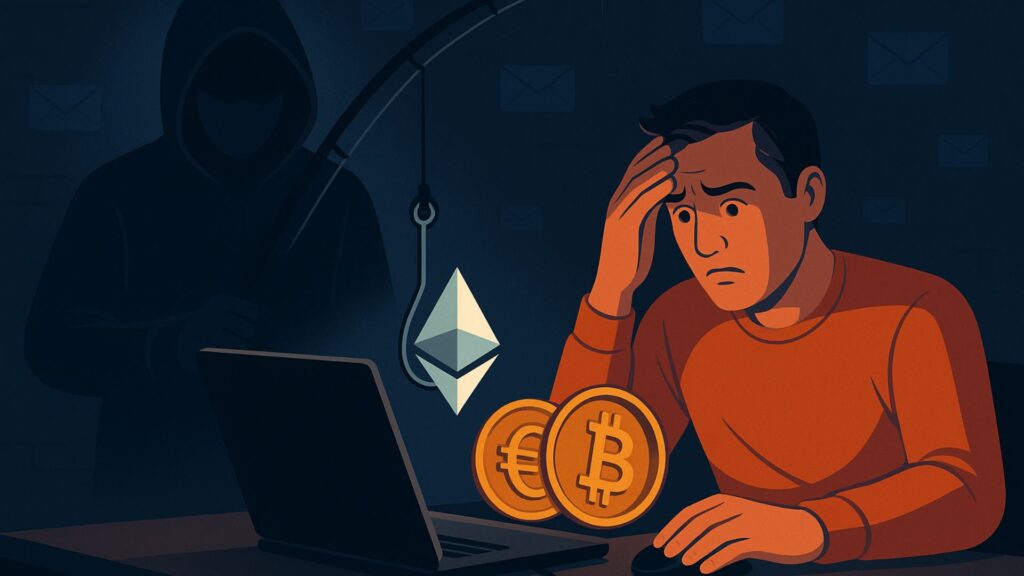The dangers of decentralised finance are often discussed in terms of complex exploits or protocol weaknesses.
Yet, the latest attack that drained $6 million from an Ethereum whale highlights a far simpler truth: convenience can be weaponised. The victim believed they were confirming harmless wallet requests. In reality, those clicks authorised attackers to seize control of millions of assets.
The Anatomy of a Gas-Free Phishing Attack
On 18 September, blockchain analysts flagged an incident that saw a single Ethereum wallet lose more than $6 million in assets, including staked Ethereum (stETH) and Aave-wrapped Bitcoin (aEthWBTC).
Unlike traditional hacks that rely on technical loopholes, this attack hinged on social engineering disguised as routine wallet prompts.
The trap was subtle. The attackers exploited Ethereum’s Permit function, designed to simplify token transfers by allowing off-chain approvals. From a user’s perspective, it seems harmless; you sign a transaction, it requires no gas, and everything looks routine. But once paired with the
The TransferFrom function, the same approval, becomes a powerful key. It grants the attacker direct access to move tokens on-chain without further interaction.
Because the transaction was gas-free, it raised no suspicion. Wallet prompts asking for permission are familiar to any user, and the absence of costs made them appear safe.
Within minutes, the whale’s holdings were siphoned away, leaving nothing but regret and a harsh reminder of how deceptive simplicity can be.
Security researcher Yu Xian from SlowMist explained the psychology of the attack. “It felt like a couple of clicks, no cost involved, and suddenly millions were gone.”
That false sense of harmlessness lies at the core of this exploit. In a world where users are conditioned to click through routine confirmations, attackers have found a near-perfect disguise.
The $6 million theft is not an isolated case. Data from Scam Sniffer shows that August alone saw more than $12 million stolen through phishing.
Over 15,000 addresses were affected, and just three wallets made up nearly half of the recorded losses. In one case, a single wallet lost $3 million in a single stroke.
Phishing has become the preferred tactic for attackers because it requires no advanced code manipulation.
Instead of battling auditors or breaking smart contract defences, attackers exploit human behaviour. Batch-signature schemes, malicious contracts, and deceptive approvals are the tools of choice. The cost to launch such attacks is minimal, yet the rewards can be vast.
This shift also reflects the maturing of DeFi infrastructure. Major exploits against protocols are harder to pull off today due to stronger audits and security measures.
By contrast, wallet-level phishing requires no compromise of protocol code. The human factor remains the weakest link, and for well-funded whales, that link is particularly attractive to attackers.
What makes this trend more alarming is that even experienced investors are falling victim. Unlimited token approvals, often granted for convenience, create fertile ground for abuse.
Once a malicious contract secures approval, the damage is instant and irreversible. The sophistication lies not in the code but in the subtlety of presentation, an approval request disguised as routine activity.
In decentralised finance, security is not only about resisting hacks. It is about recognising that the architecture of trustless systems places full responsibility on the individual. When scammers can mimic harmless interactions so convincingly, the risks become universal.
Protecting Yourself from Phishing in Web3
The lesson from this $6 million theft is clear: the most dangerous threats are not always technical, but behavioural. Protecting yourself requires vigilance, scepticism, and an understanding of how convenience tools like Permit functions can be exploited.
First, treat every wallet approval request with suspicion. If you do not understand why a contract requires access, decline the request. Unlimited approvals in particular should be avoided.
Whenever possible, restrict approvals to specific amounts rather than granting open-ended permissions.
Second, use wallet security tools that monitor and flag risky approvals. Several services exist to scan transactions before you sign them, highlighting potential risks in plain language. These tools cannot guarantee absolute safety, but they provide an additional layer of defence against deception.
Third, consider using multiple wallets for different purposes. Keep a primary wallet for high-value holdings that rarely interact with new contracts, and a separate “hot” wallet for experimental activity or dApps. This separation reduces the chances that one mistake results in catastrophic losses.
Fourth, stay informed. Phishing tactics evolve rapidly, and awareness of the latest methods is one of the strongest defences. Following trusted security researchers and DeFi watchdogs can keep you updated on new threats.
Finally, never underestimate the value of caution. If a transaction feels unnecessary, if the request appears unfamiliar, or if you are pressured to act quickly, step back. Decentralised systems provide no undo button. Once approval is granted and tokens are drained, recovery is nearly impossible.
This is not about paranoia but about discipline. Scammers rely on complacency and routine. Breaking that pattern by pausing, verifying, and questioning each interaction can mean the difference between safety and disaster.
Conclusion
The theft of $6 million from an Ethereum whale is not just another entry in the growing ledger of DeFi losses.
It is a reminder that in decentralised finance, human error remains a greater threat than faulty code. Phishing has become the weapon of choice for attackers precisely because it bypasses technical safeguards and exploits the simplest of actions: a click.
Staying safe requires a mindset of scepticism and responsibility. Guard your approvals, separate your wallets, and question every interaction. In a financial system where ownership comes with complete control, that same control can be your undoing if misplaced.
The decentralised future promises freedom, but only for those prepared to protect themselves from the traps hidden in plain sight.

